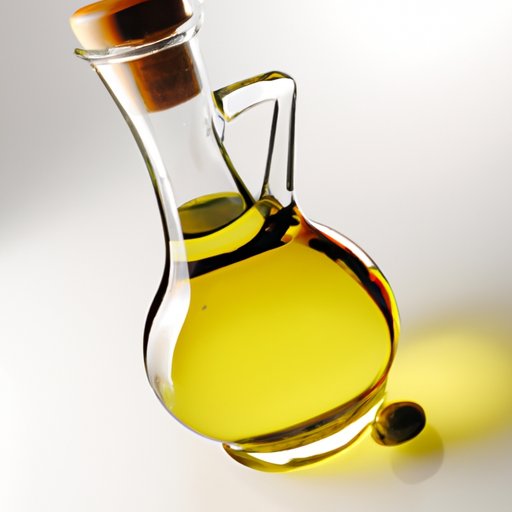Introduction
When it comes to maintaining a healthy diet, understanding the nutritional content of the food we eat is important. Oils, in particular, can be tricky to measure accurately, which can make it difficult to stick to recommended calorie goals. Olive oil, a popular cooking oil, is no exception. In this article, we’ll explore how many calories are in olive oil and provide tips and recipes for using it in moderation.
The Benefits of Using Olive Oil
While all oils contain calories, not all oils are made equal. Olive oil, in particular, is a heart-healthy option that provides several health benefits. According to the American Heart Association, consuming olive oil may lower the risk of heart disease due to its high monounsaturated fatty acid content. Additionally, olive oil has anti-inflammatory properties and is rich in antioxidants, which can help reduce the risk of chronic diseases. Compared to other commonly used oils like vegetable or canola oil, olive oil has a similar caloric value but provides additional health benefits.
A Guide to Measuring Olive Oil
To accurately measure olive oil, use a food scale or measuring spoons. According to the USDA, one tablespoon of olive oil contains approximately 119 calories. When cooking, use olive oil in moderation to stay within recommended calorie goals. One tablespoon of olive oil is often enough to coat the pan or dress a salad. Using an oil spray bottle is another way to ensure you’re using the right amount of oil.
The Nutritional Profile of Olive Oil
In addition to its health benefits, olive oil is also rich in nutrients. According to the USDA, one tablespoon of olive oil contains 10 grams of monounsaturated fat, which can help reduce cholesterol levels. Olive oil also contains vitamin E, an antioxidant that helps protect cells from damage. When choosing olive oil, opt for extra-virgin olive oil, which is less processed and retains more of its nutrients. Use regular olive oil for sautéing or frying as it has a higher smoke point and can tolerate higher temperatures than extra-virgin olive oil.

Comparing Olive Oil to Other Oils
While olive oil is a healthy option, it’s not the only oil available. Other commonly used oils like vegetable, canola, and coconut oil also have varying caloric values and nutritional profiles. According to the USDA, vegetable oil contains 120 calories per tablespoon, canola oil contains 124 calories per tablespoon, and coconut oil contains 117 calories per tablespoon. While these oils may have some health benefits, they are often processed and lack the additional nutrients found in olive oil.
Tips for Using Olive Oil in Moderation
Like any oil, it’s important to use olive oil in moderation to maintain a healthy diet. One way to do this is to use olive oil as a substitute for other oils in recipes. For example, use olive oil instead of butter on bread or use it as a dressing for salads instead of high-calorie dressings. When cooking, use a non-stick pan or cooking spray to reduce the amount of oil needed. Lastly, remember to measure out the oil before using it to avoid using too much.
Recipes that Use Olive Oil in Moderation
Using olive oil in moderation doesn’t mean sacrificing flavor. There are plenty of healthy recipes that incorporate olive oil. Here are a few examples:
Mediterranean Quinoa Salad
This salad is a perfect side dish and is packed with protein and fresh vegetables.
- 1 cup cooked quinoa
- 1 small cucumber, diced
- 1 small red onion, diced
- 1 can chickpeas, drained and rinsed
- 2 tbsp olive oil
- 2 tbsp lemon juice
- 1/4 cup chopped fresh parsley
- Combine quinoa, cucumber, red onion, and chickpeas in a bowl.
- In a separate bowl, whisk together olive oil, lemon juice, and parsley.
- Pour dressing over salad and mix until well combined. Serve chilled.
Roasted Parmesan Broccoli
This side dish is easy to prepare and is a healthy alternative to traditional roasted vegetables.
- 1 head of broccoli, chopped into florets
- 2 tbsp olive oil
- 1/4 cup grated parmesan cheese
- 2 cloves garlic, minced
- Preheat oven to 400°F.
- In a large bowl, toss broccoli with olive oil and garlic.
- Roast in the oven for 15-20 minutes, turning halfway through.
- Sprinkle parmesan cheese over broccoli and roast for an additional 5 minutes or until cheese is melted. Serve hot.
Understanding the Role of Olive Oil in a Healthy Diet
Incorporating olive oil into a balanced diet is important for overall health. The Dietary Guidelines for Americans recommend consuming 5-7 teaspoons of oil per day for adults, with a focus on using oils that are high in healthy fats and nutrients. Olive oil is a great option for meeting this recommendation, as it provides several health benefits in addition to its caloric value.
Conclusion
Now that you know how many calories are in olive oil and how to use it in moderation, you can enjoy this heart-healthy oil without worrying about exceeding your calorie goals. Remember to measure out your oil and use it as a substitute for other oils in recipes to stay within recommended guidelines.
